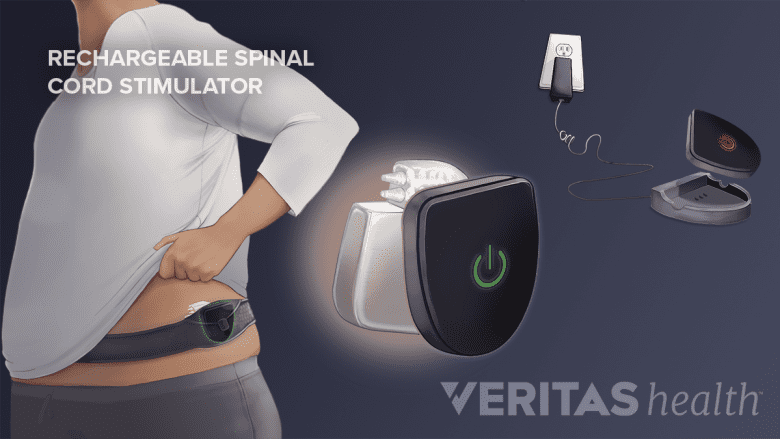While a rechargeable spinal cord stimulator (SCS) can last several years longer than a traditional SCS before needing a replacement surgery, a potential drawback is the need to regularly recharge the device. The process of recharging a rechargeable SCS can vary depending on the device and individual needs and preferences.
In This Article:
- Rechargeable Spinal Cord Stimulators for Chronic Pain
- When to Consider Getting a Rechargeable SCS
- Recharging a Rechargeable SCS
- Risks of Rechargeable SCS
How Recharging an SCS Works
To recharge a rechargeable SCS battery, the charger is placed over the implanted device under the skin.
When an SCS device’s battery starts to get low, it sends an alert that a recharge is soon needed. The recharge process typically includes:
- Taking the fully-charged charger (from a base station) and placing it over the skin where the implanted SCS device is located. Many systems include a belt to conveniently hold the charger where it needs to be.
- Aligning the charger’s internal antenna so that it can maximize the signal strength from the charger to the SCS device. Adjusting the angle of the charger and/or the belt can help optimize the signal strength. Wearing light-weight clothes or fewer layers can also help.
- Once the charger has begun recharging the SCS device, it can take 45 minutes to several hours to charge, depending on the device.
While the SCS device is recharging, sleep is to be avoided because an unmonitored charger could cause a burn or the antenna could get out of place and stop charging. Instead, relaxing activities are encouraged while the device is charging, such as watching a movie or reading.
How Often an SCS Must Be Recharged
Reports vary regarding how often a rechargeable SCS must be recharged. Many estimates are about once a week, but patients have reported needing to recharge closer to once every other day or even just once a month. Factors that can influence how often an SCS must be recharged include:
- Battery size. Some devices are equipped with a larger (or more efficient) battery and naturally can last longer before needing to recharge.
- Battery age. Over time, the device’s battery must be recharged more frequently as it functions less efficiently with age.
- Therapy settings. The SCS can be programmed in different ways, depending on the nature of the pain and therapy needs. For example, if multiple programs are running at the same time on the device, the battery will run down sooner. Similarly, if the therapy settings send longer (rather than shorter) pulses, more energy is used.
- Stimulator usage. Severe pain may require more frequent device usage, causing the device’s battery to run down sooner compared to devices that are only used sparingly.
- Electrode type. A padded electrode tends to use less energy than a percutaneous lead.
- Device location. The area of the spine that needs stimulation can affect how much energy is used. For example, more energy is expended by stimulating the lumbar spine than the cervical spine. A rechargeable SCS used for the neck will likely last longer before needing to be recharged.
- User preference. Some users prefer shorter recharge times and are willing to recharge their device more often. For example, if a full recharge of a low battery takes about 8 hours once a week, some patients might prefer a 2-hour recharge every other day.
It is important to read the device’s directions regarding when it should be recharged. Allowing the device’s battery to get too low could damage the battery.
Editor’s Top Picks
- Spinal Cord Stimulation for Chronic Back Pain Video
- Who May Benefit from Spinal Cord Stimulation
- Spinal Cord Stimulation for Chronic Back and Neck Pain
- Recovery After Spinal Cord Stimulator Implant Surgery
- Spinal Cord Stimulation for Chronic Neck Pain Video
- Spinal Cord Stimulators and Pain Pumps: Implantable Systems for Neuropathy






